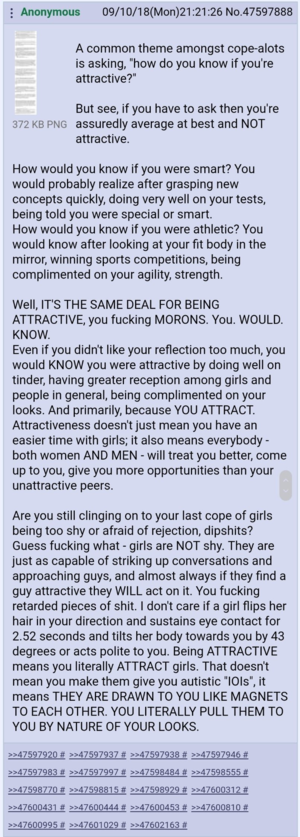Attraction ambiguity problem
The attraction ambiguity problem, or "how do I know if she/he's interested in me?" is an issue commonly experienced by those who are not very experienced in the dating realm.
Usually, people are either bad at reading faces[1] (possibly due to autism), or are genuinely not getting definite indicators of interest.
There is a great controversy surrounding the ambiguity problem, with some saying it is a death knell and the person will never be interested in you, and others claiming that you need to know for sure, and the only way to do that is to ask the person out. Regardless, there are certain indicators of when ambiguity is irrelevant or it is actually a negative sign.
Significance[edit | edit source]
Usually, before getting to know a person well, ambiguity is normal. It is highly unlikely that a person will be into you immediately if you are into them as well. In fact, it is so rare, that its occurrence is glorified in movies! Simply put, the chances of mutual attraction at the very beginning are low unless one or both partners have very good physical appearance and/or social standing. This does not mean it is low enough to not be experienced; many, if not most experience mutual attraction at the beginning, but many others do not. So ambiguity at the beginning is not much of an issue.
As prospective partners get to know each other, however, one must look for indicators of interest. The time two people take to realize they are a good match for one another can vary based on circumstances, but within a reasonable time frame, there should be some flirting on at least a minimal level.
Negative signs[edit | edit source]
If the initial period of getting to know a person has passed, certain signs can indicate a lack of interest. If the person:
- is rather superficially emotional around you,
- appears to be not very interested in you or your conversations,
- appears to be more interested in other prospective partners or other things (e.g. texting on a phone), or
- doesn't seem overly interested in spending that much time with you,
then it is likely that person is not interested in you and you should move on. This is different from shyness, where there are distinct inhibitions surrounding the matter of escalation. Careful attention is needed to not confuse shyness with disinterest, though a good litmus test is if the person is not shy around other people or appears to be treating others much more warmly.
False attraction signals[edit | edit source]
Some normies will give false attraction or even acceptation signals to make fun of people they deem subhuman or strange. Those normies do those fake signals for the sake of being ironic; they want to make fun of people they deem not worthy of any respect or sympathy. If you are not NT enough, you may not understand that those signals are fake, so be careful. Those fake signals can be any form of IOI, including fake love confessions, fake love letters, fake (unsincere or double-meaning) compliments, or fake dates proposals. See for example at Chris Chan: A Comprehensive History - Part 11 and Chris Chan: A Comprehensive History - Part 13.
See also[edit | edit source]
- Approach anxiety
- Butterflies in the stomach
- Shyness
- Love shy
- Indicator of interest
- Oneitis
- Boyfriend objection

